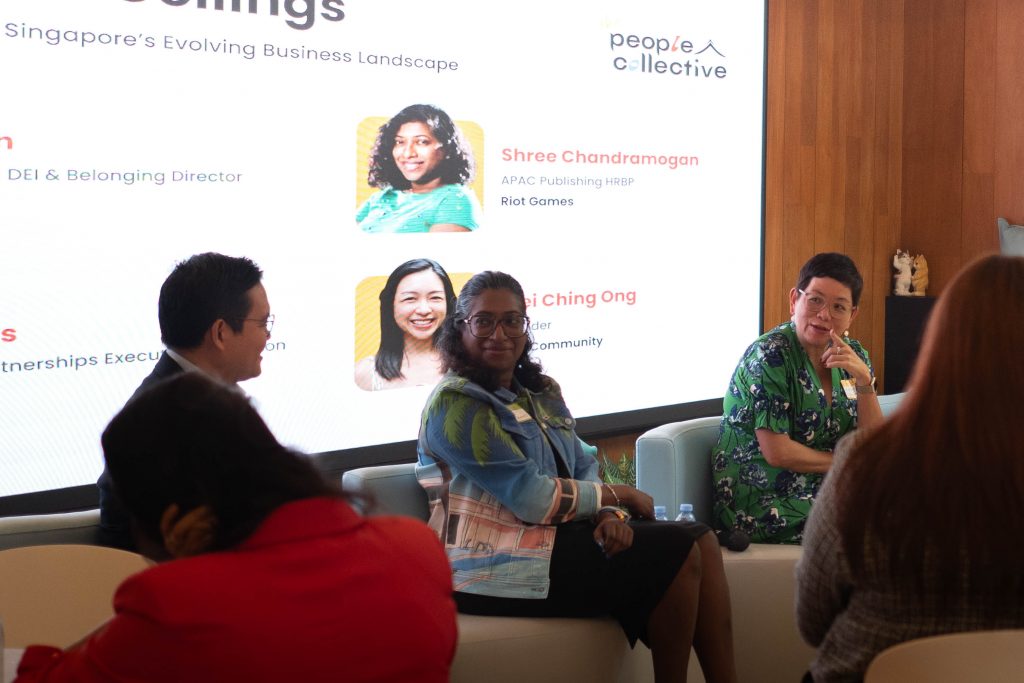Women are a leading force in today’s business landscape. Yet while women represent over half the global workforce, less than a third (32%) of leadership positions are held by women.
Women are also underrepresented in high-growth sectors like technology, information, and media. This creates a double whammy, where women are both less likely to be in these sectors and may face a skills gap if they try to enter.
The People Collective (TPC)—a Slack community for HR professionals across Southeast Asia and beyond—recently hosted an in-person workshop in celebration of International Women’s Day for People leaders to discuss and learn strategies for empowering women to lead in Singapore (and across the region). Inspired by the insightful discussions and drawing on the experiences of our community, this blog explores actionable tips for women and organizations to address skills gaps and promote growth.
Understanding the Skills Gap: Beyond Metrics

Bridging the skills gap for female talent requires a deeper understanding of their needs and aspirations. A deeper skills gap analysis is needed to deliver programs and strategies that will have a lasting impact on your organization. Here’s why a one-size-fits-all approach won’t work:
Beyond Promotion Paths
Recognizing the various definitions of success and professional development is crucial for promoting growth within your organization. Panelist Wei Ching Ong, Founder of SELF, encourages us to question, “is the professional track, which is often the manager track, really what women want?”
This question highlights a potential disconnect between traditional promotion paths focused on management and the aspirations of some women. Understanding these aspirations through strategies such as self-identification surveys (more on this later) is crucial. These surveys can help reveal whether women seek leadership roles, prefer individual contributor tracks, or have specific skill sets they want to develop.
Questioning the Numbers
Metrics like promotion rates are important, but they don’t tell the whole story when it comes to addressing the skills gap. Wei Ching further emphasized the need to “question the metrics.” Gathering qualitative information through focus groups or open-ended survey questions can provide valuable insights into the lived experiences of women in the workplace. This can help uncover the reasons behind the skills gaps we see in the data.
By looking beyond surface-level data and understanding the aspirations and challenges women face, organizations can design targeted skills development programs that empower them to reach their full potential.
Women Face Different Skill Development Opportunities
A McKinsey report highlights that women are less likely than men to participate in formal training and development programs, putting them at a disadvantage when it comes to acquiring new skills. This draws an emphasis on understanding the needs, learning styles, and unique challenges of your workforce. By tapping into motivational factors, goals, and needs of your employees, you can better target skills gap analysis.
Strategies to Bridge the Skills Gap
Bridging the skills gap within your organization will require a more tailored approach than simply rolling out learning and development (L&D) benefits. The TPC community dove into specific strategies HR leaders and organizations can take to approach addressing the skills gap. Here, we take a look at various strategies from both the individual and organizational level.
For Women
Organizations and leaders certainly have a responsibility and role to play in addressing the skills gap within their teams, but women also have a stake in the game. It’s essential to have the buy-in and participation of employees to help address and close skills gaps.
Self-awareness and Aspiration Identification
Panelist VJ Posadas, Director of Corporate Partnerships Executive Education at INSEAD aptly pointed out, “The first part of the framework is really understanding oneself and whether you’re a woman or a man, it’s always who am I? Who do I want to be? Do I really want to aspire to be a CEO or a CFO, or am I happy to be an individual contributor providing value to my organization?”
Identifying individual career goals provides direction to skills gap analysis. Often, this can be supported on the managerial level, with regular 1-on-1 check-ins, routine performance reviews, and goal setting exercises to help guide employees to best understand their goals and key drivers.
Continuous Learning and Development
To bridge the skills gap, it’s crucial for employees to become active participants in their own growth journey. This can be done by researching in-demand skills for their industry and leadership role, exploring online courses, workshops, or certifications offered by professional organizations, and reaching out to managers for additional resources.
Taking the initiative to learn new skills demonstrates an impressive level of commitment and ambition, and helps get the training and resources needed to close skills gaps.
Further, embracing challenging assignments as opportunities to showcase capabilities, and seeking mentorship and guidance from experienced professionals are great ways for women to advocate for their own continuous development.
Build a Support Network
The career development path can be lonely without support. Our community agreed that seeking out support from peers and mentors is essential to growth and development. Whether it’s prompting discussions with friends, colleagues, or superiors, taking the time to ponder the challenges, desires, and strategies to skills gap analysis can help answer a lot of unknowns.
The People Collective offers a supportive network of like-minded individuals, as well as thoughtful events and workshops to help further skills development.
For Organizations
Leadership has an obligation to their talent to invest in their growth, both because it’s the right thing to do, and also because it helps promote employee engagement, retention, and productivity. The panelists and audience discussed the various ways in which organizations can address skills gap from a strategic level.
Tailored Skills Development Programs
Learning and development is a major factor in career growth and performance coaching, but not all skills development programs are created equal. When considering strategies to specifically champion women leaders, consider skills areas that have historically been pain points. For example, effective communication is essential for leadership success, and is often regarded with double standards for women and men.
“Women leaders often downplay their accomplishments or hesitate to speak up in meetings. Developing strong communication skills is essential to project confidence and inspire your team.”
Kathy Teoh, Global Strategic DEI & Belonging Director at Arcadis
From strengthening communication and advocacy skills to addressing skill gaps in historically male-dominated industries such as programming and engineering, our panel discussions highlighted the importance of tailored skills development programs that equip women leaders with the confidence and skills to navigate challenging situations and inspire their teams.
This also means understanding the learning styles that best suit your team. While some employees may benefit from group seminars or in-person workshops, others may best learn from digital training courses or one-on-one mentoring sessions.
Value Individual Contributor Paths
Wei Ching stressed the importance of honoring individual contributors as well as those that want to join the leadership track. “Some employees actually prefer an individual contributor track and that’s fine. But has the organization been designed to support growth as an individual contributor? I think more often than not you hear a narrative that you have to be a manager to show that you are making progress. But that doesn’t necessarily have to be true.”
Career paths that support learning outside of management roles allow growth across the board, and help address the skills gap beyond leadership skills. Ensure your organization is nurturing all employees, wherever they are and whatever their individual goals may be.
Data-Driven Decision Making
Like any workplace management decision, gathering data helps leadership make informed decisions that will better serve their workforce. Gather both quantitative and qualitative data on the demographics, goals, skills gap, and current abilities of your organization to best develop targeted programs to support employees.
Using this data to understand the reasons behind a skills gap can unlock a better understanding of where L&D efforts should be focused. Is it that there aren’t enough opportunities for growth? Your policies don’t support the needs of your employees? Engagement is low?
When we apply data to our decisions, we reduce the opportunity for misalignment, bias, and assumptions that can undermine our efforts to promote a more equitable environment.
Mentorship and Sponsorship Programs
Finally, consider leveraging the skills and experiences of leaders within your organization. Mentorship is valuable, but sponsorship takes championing women a step further. Mentorship focuses on guidance and advice, whereas sponsorship is about advocacy and opportunity. A sponsor is someone who can use their influence to promote you and your work to others. They can recommend you for opportunities, introduce you to important people, and speak on your behalf.
As panelist VJ Posadas stressed, “Women are over-mentored but under-sponsored. One way we can use our male privilege for allyship to make women’s work more visible is by getting men involved in being their sponsors.”
Of course, women leaders can and should continue to be coached and mentored by fellow women as their experiences are often relatable. Encouraging sponsorship programs can connect women with influential advocates who can champion their advancement.
Join The People Collective

HR professionals are setting the standard for championing women, and doing the hard work of navigating the way to successful advancement. At the People Collective, we’re committed to bringing like-minded and skilled HR leaders together to share resources, spark important conversations, and promote collective action to better the world of work. These are just some of the insights shared during a recent People Collective event.
If you haven’t already, join our vibrant community of HR leaders that make up our Slack community.
Follow us on LinkedIn to stay up to date on the latest community gatherings and discussions.


